Wasaga Beach, Ontario
To Lithuanians, Wasaga Beach is the „Palanga of Canada“. This no little feat since Palanga is the largest resort of Lithuania and one of the largest on the Baltic Sea.
Lithuanians who moved to Canada after World War 2 had nostalgic feelings to Palanga and, once it became possible, they bought their own summer homes in the area near Toronto that resembled Palanga the most: the pretty coasts and forests of Wasaga Beach.
Lithuanian camp „Kretinga“of Wasaga Beach
„Kretinga“ Lithuanian camp of Wasaga Beach is far more than a campsite: it is a kind of Lithuanian village that attracts Lithuanian children and teenagers from all over Canada. During summers, each week is dedicated to some particular group of people (e.g. „Lithuanian-speaking teens“, „English speaking teens of Lithuanian descent“) who come to „Kretinga“ and spend the week in a forest amidst Lithuanian symbols.

Main Hall of the Kretinga Camp
Among such symbols is the mystical Kretinga Hill of Crosses in the forest having a few large crosses and modeled after the one in Šiauliai. Crosses include one based on the Ateitininkai symbol (a Lithuanian Christian youth organization), one dedicated to Algirdas Trumpickas (influential in the operation of "Kretinga" camp), one wooden post is dedicated to Kretinga camp itself (1992). One of the crosses is symbolically fallen down.

Kretinga Hill of Crosses
In the center of the camp, the main hall has its walls covered in Lithuanian artworks created by the visitors of the camp (each year a new one is made). One mural is on the exterior – it depicts the history of Lithuanian independence (1987-1991). Next to the building, a map of Lithuania is a land art that shows the map of the old big Lithuania (before World War 2).
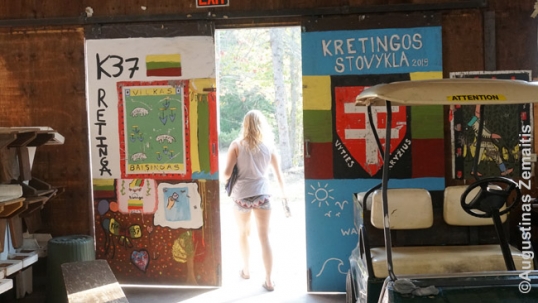
Artwork inside the Main Hall of the Kretinga Camp
The map is deteriorated though as the camp has been established in 1955.
There are also basketball courts and buildings where those camping lives at. ~100 children camp there at a single time.

Kretinga Map of Lithuania land art
Three streets around Kretinga camp are named in Lithuanian: Wydunas (after a Lithuanian philosopher Vydūnas), and Nida, as well as Baltic Street.
Kretinga itself is named after a Lithuanian city of Kretinga, the first one where Franciscan monks became established in Lithuania. That is because Krteinga is owned by Franciscans. It thus also includes numerous religious references, including a small Jurgis Matulaitis Catholic chapel, a mass during the camp activities and, rather unusually, a pet cemetery: Lithuanian Franciscans of Canada have a tradition of keeping a pet in their monastery of Toronto and Kretinga is where they are buried after death.
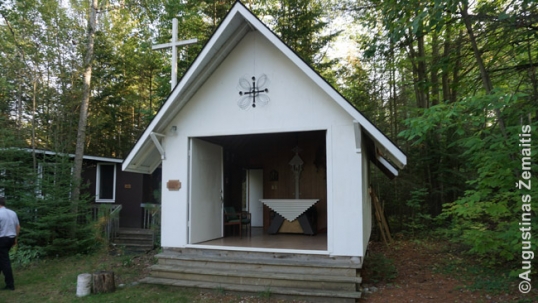
Kretinga chapel of Blessed Jurgis Matulaitis
Wasaga Beach Lithuanian church
Wasaga Beach Lithuanian church of Good Shepherd is located in a small building on the opposite side of Wasaga Beach from „Kretinga“, some 20 km away.
The church has a unique design: its main room can be transformed from a church into a hall by merely covering the altar. The back wall of the church also opens, allowing the alter and the priest to be visible from the outside where there also pews and the faithful could gather. Very appropriate for a church of a resort.

Wasaga Beach Lithuanian church of Good Shepherd looking from its external pews
The austere interior still has a galore of Lithuanian symbols. The altar is surrounded by Lithuanian symbols, among the most prominent being the Three Crosses, one of the symbols of Vilnius that has been destroyed by the Soviets at the time Wasaga Beach church was constructed. Also, there is Rūpintojėlis, a Lithuanian flag, a copy of Our Lady of Vilnius painting.
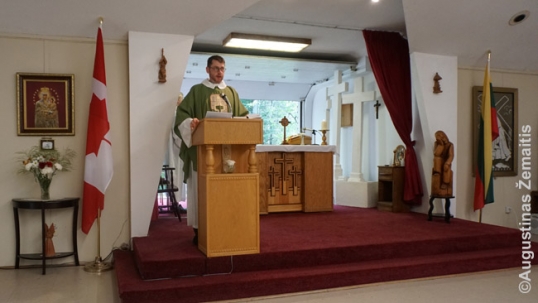
Priest during mass inside the church. The open area is behind him.
On the front of the church, there is a Lithuanian traditional wooden cross, as well as Lithuanian wooden artworks relocated from London (Ontario) Our Lady of Šiluva Lithuanian church that had been demolished.

Wooden chapel-post (right) and the artworks relocated from London, Ontario (left) on the front of Wasaga Beach Lithuanian church
In the 1950s or 1970s, Wasaga Beach was largely a summer community and thus no year-round mass or Lithuanian activities took place. When the small church was constructed in 1955, it was constructed as a summer-only edifice. It mostly served the local Good Shepherd camp, owned by what is now the Lithuanian Martyrs parish of Mississauga. However, this camp was later (1973) closed down in favor of Camp Kretinga. Its buildings were demolished, save for the church and the so-called „rectory“ behind the church now used for post-Mass events and essentially serving as a small Lithuanian club.

Wasaga Beach Lithuanian church from the other side of the road
While kids left this area of Wasaga, more and more older people came in: many of them would leave Toronto or Hamilton for good when retired, moving to their summer homes in Wasaga Beach. In 1974, 3 Lithuanian families permanently lived in Wasaga Beach and 15-16 in the surroundings and the numbers were growing.
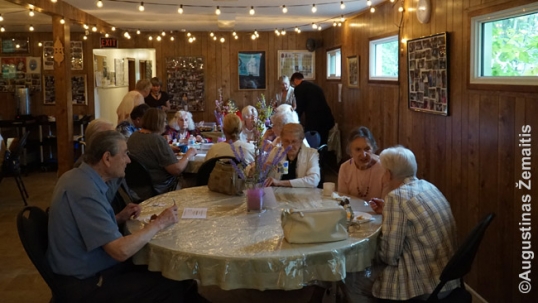
Inside the Wasaga Beach rectory after the mass
In 1993, the Good Shepherd mission was thus consecrated as a permanent church, now heated in winter. In the summers, the church used to be full both inside and outside while in the winters, as temporary residents would move out, it is less full.
Midland Lithuanian Martyrs shrine
The cozy and impressive hilltop Canadian Martyrs Shrine in Midland (35 km from Wasaga Beach) may be dedicated to the Jesuit missionaries who were killed by Native Americans and be a popular place for Canadian pilgrimage.
However, in 1957, Lithuanians chose the shrine as a site to erect their own cross for Lithuanian Martyrs, reminding Canada that while being killed for your faith may have been a distant sad past in America, it was still a real issue „behind the Iron Curtain“ where religious Lithuanians were persecuted by the Soviet atheist regime. The cross was initially wooden but replaced by a more permanent metal one in 1972.

Lithuanian Martyrs cross in Midland (the Canadian Martyrs shrine is behind it as it is the first and one of the closest ethnic shrines to the main shrine)

The original Lithuanian cross (image courtesy of the Lithuanian museum-archive at Mississauga)
The Lithuanian cross then became a destination for annual Lithuanian pilgrimages. More impressively, the cross began a tradition among Canada‘s minorities to create their own shrines near the Canadian Martyrs shrine, thus making the surroundings of the shrine into a kind of an international religious park where one can see how the same Christian faith may have different symbols and interpretations in different countries.

Canadian Martyrs shrine as seen from the road
Interestingly, the Polish shrine also includes a sculpture of Divine Mercy, based on the painting of Divine Mercy that was painted (and still exists) in Vilnius, Lithuania. That is because the painting was created according to visions of a Polish nun Faustina Kowalska, who resided in Vilnius at the time. Arguably Divine Mercy has an even bigger following in Poland than in Lithuania.
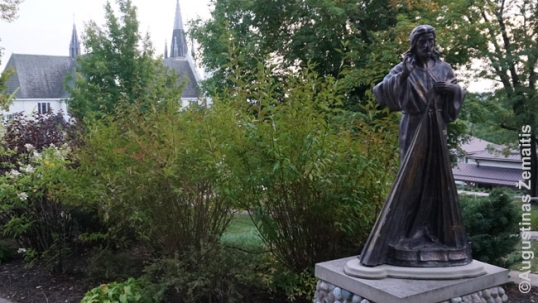
Divine Mercy statue at the Canadian Martyrs Shrine
The map of Lithuanian heritage sites of Wasaga Beach area
All the Lithuanian heritage locations of Wasaga Beach are marked on this interactive map, made by the "Destination Lithuanian America" expedition (click the link):




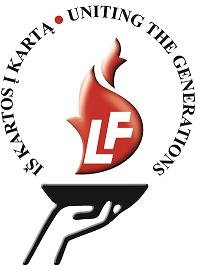

Leave a comment